Bird R.B., Stewart W.E., Lightfoot E.N. Transport Phenomena
Подождите немного. Документ загружается.


5A.3
Tensor Operations in Terms of Components
817
4.
If the components of the tensor are formed by ordered pairs of the components of
two vectors v and w, the resulting tensor is called the
dyadic product of
v and w
and given the symbol vw:
Note that vw
#
wv,
but that
(vw)~
=
wv.
5.
If the components of the tensor are given by the Kronecker delta
S,.,
the resulting
tensor is called the
unit
tensor
and given the symbol 6:
The magnitude of a tensor is defined by
1
7
1
=
7
=
v$(T:Tt)
I
Addition of Tensors and Dyadic Products
Two tensors are added thus:
a
+
T
=
2
2
6i9u,
+
2
x
=
2
2
6,S,(u,
+
rij)
(A.3-12)
1
i
i
i
j
That is, the sum of two tensors is that tensor whose components are the sums of the cor-
responding components of the two tensors. The same is true for dyadic products.
Multiplication of a Tensor by a Scalar
Multiplication of a tensor by a scalar corresponds to multiplying each component of the
tensor by the scalar:
ST
=
s
The same is true for dyadic products.
The Scalar Product (or Double Dot Product) of Two Tensors
Two tensors may be multiplied according to the double dot operation
in which
Eq.
A.3-1
has been used. Similarly, we may show that
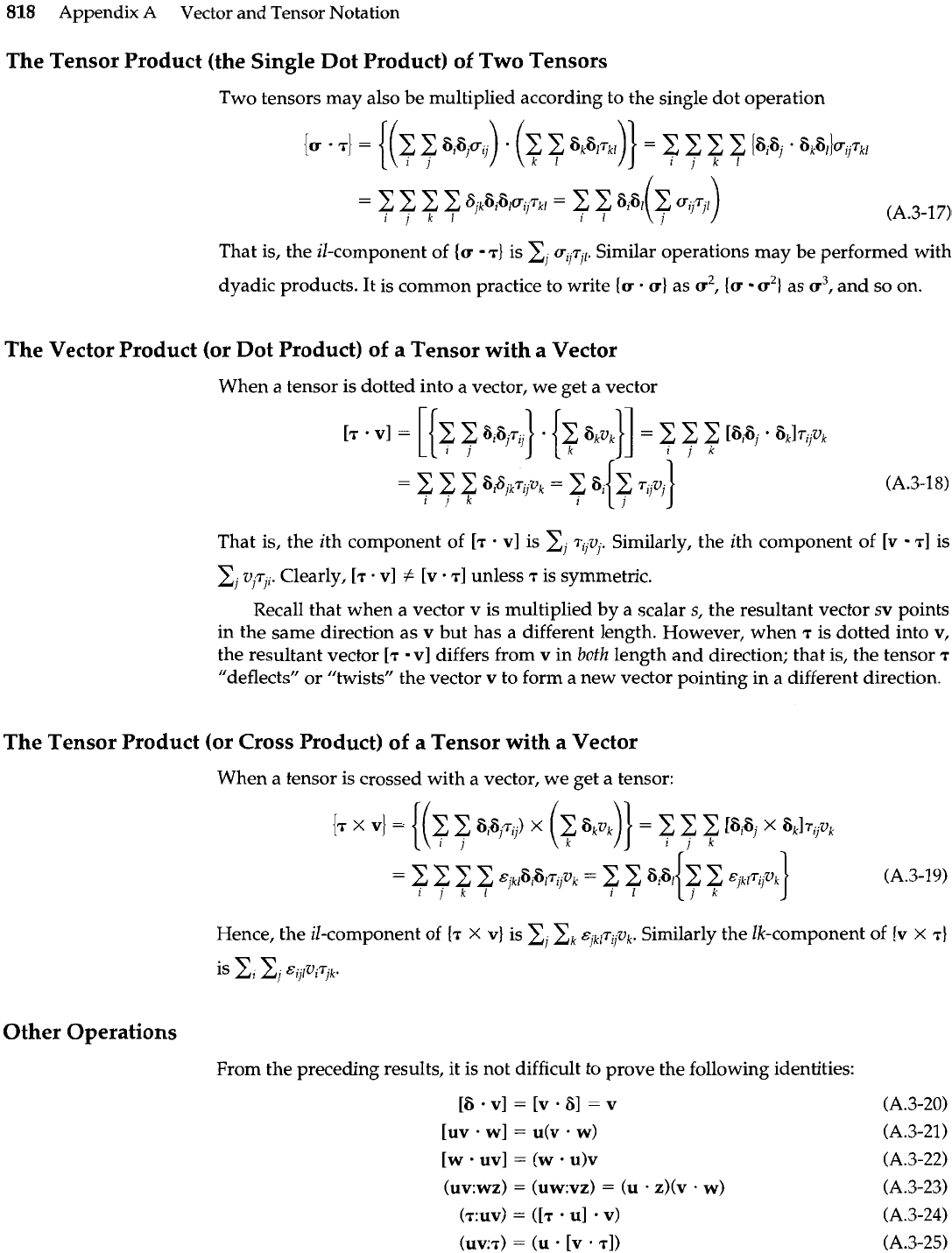
818
Appendix A Vector and Tensor Notation
The Tensor Product (the Single Dot Product) of Two Tensors
Two tensors may also be multiplied according to the single dot operation
=
z
2
C
Sjk&%I17kl
=
2
z
rib
2
uijrjl
tjkl
i
I
(j
)
(A.3-17)
That is, the il-component of
{u
T}
is
Xi
uijrj1.
Similar operations may be performed with
dyadic products. It is common practice to write {u
.
a}
as
u2,
{u
u21
as u3, and so on.
The Vector Product (or Dot Product) of
a
Tensor with
a
Vector
When a tensor is dotted into a vector, we get a vector
That is, the ith component of
[I
.
v]
is
2,
rVvi'
Similarly, the ith component of
[v
TI
is
zj
vj9.
Clearly,
[T
.
v]
Z
[v
.
TI
unless
T
is symmetric.
Recall that when a vector
v
is multiplied by a scalar
s,
the resultant vector
sv
points
in the same direction as
v
but has a different length. However, when
T
is dotted into
v,
the resultant vector
[T V]
differs from
v
in
both
length and direction; that is, the tensor
I
"deflects" or "twists" the vector
v
to form a new vector pointing in a different direction.
The Tensor Product (or Cross Product) of
a
Tensor with
a
Vector
When a tensor is crossed with a vector, we get a tensor:
Hence, the il-component of
{T
x
v)
is
Xi
2,
Similarly the lk-component of
{v
x
T)
is
Zt
xj
qjpirjk
Other Operations
From the preceding results, it is not difficult to prove the following identities:
[S
.
v]
=
[v
-61
=
v
[uv
'
w]
=
u(v
'
w)
[W
'
uv]
=
(w
'
u)v
(uv:wz)
=
(uw:vz)
=
(u
.
z)(v
.
w)
(7:uv)
=
([T
'
ul
'
v)
(uv:7)
=
(u
'
[v
'
TI)
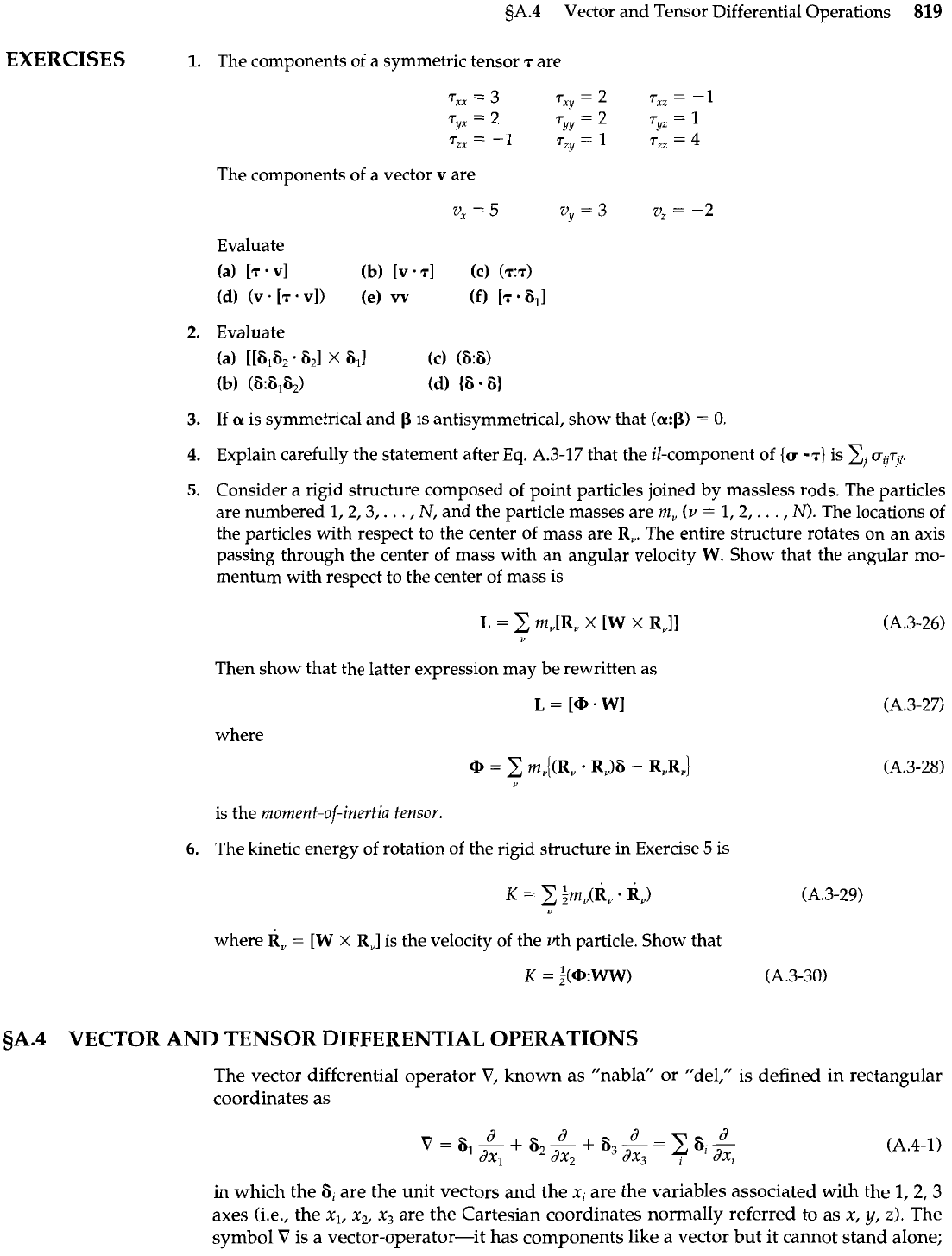
gA.4 Vector and Tensor Differential Operations
819
EXERCISES
1.
The components of a symmetric tensor
T
are
The components of a vector
v
are
3.
If
a
is symmetrical and
P
is antisymmetrical, show that
(a$)
=
0.
4.
Explain carefully the statement after
Eq.
A.3-17 that the il-component of
{cr
T)
is
2,
(JjjT,p
5.
Consider a rigid structure composed of point particles joined by massless rods. The particles
are numbered 1,2,3,.
.
.
,
N,
and the particle masses are
m,
(v
=
1,2,
. . .
,
N).
The locations of
the particles with respect to the center of mass are
R,.
The entire structure rotates on an axis
passing through the center of mass with an angular velocity
W.
Show that the angular mo-
mentum with respect to the center of mass is
Then show that the latter expression may be rewritten as
where
is the moment-of-inertia tensor.
6.
The kinetic energy of rotation of the rigid structure in Exercise
5
is
where
R,
=
[W
x
R,]
is the velocity of the vth particle. Show that
5A.4 VECTOR AND TENSOR DIFFERENTIAL OPERATIONS
The vector differential operator
V,
known as "nabla" or 'Idel," is defined in rectangular
coordinates as
in
which the
6,
are the unit vectors and the
xi
are the variables associated with the 1,2,3
axes (i.e., the
x,,
x,,
x,
are the Cartesian coordinates normally referred to as
x,
y,
z).
The
symbol
V
is a vector-operator-it has components like a vector but it cannot stand alone;
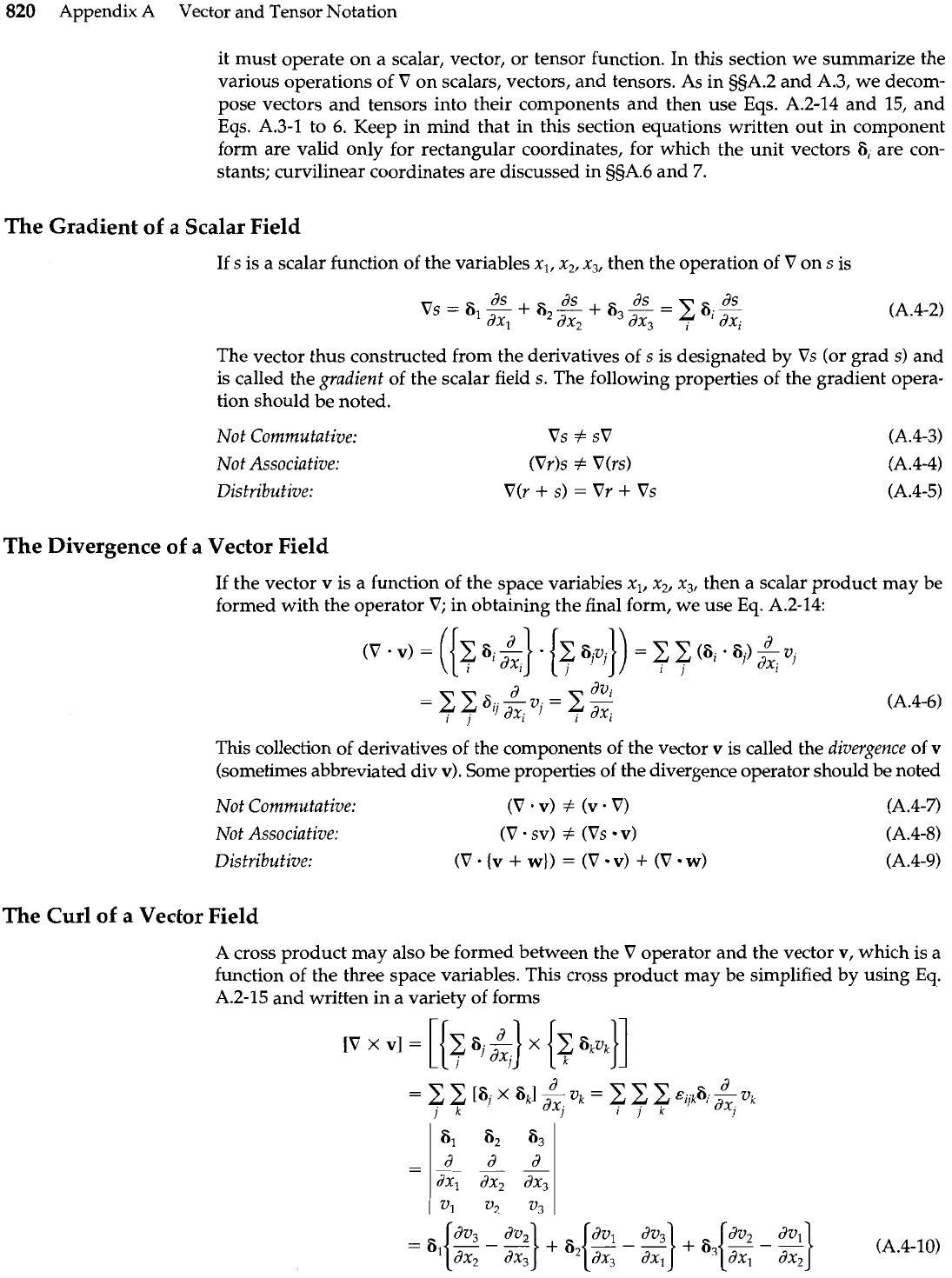
820
Appendix A Vector and Tensor Notation
it must operate on a scalar, vector, or tensor function. In this section we summarize the
various operations of
V
on scalars, vectors, and tensors. As in 5sA.2 and A.3, we decom-
pose vectors and tensors into their components and then use Eqs. A.2-14 and 15, and
Eqs. A.3-1 to
6.
Keep in mind that in this section equations written out in component
form are valid only for rectangular coordinates, for which the unit vectors are con-
stants; curvilinear coordinates are discussed
in
9SA.6 and
7.
The Gradient of a Scalar Field
If
s
is a scalar function of the variables x,, x,, x,, then the operation of
V
on
s
is
The vector thus constructed from the derivatives of
s
is designated by
Vs
(or grad
s)
and
is called the
gradient
of the scalar field
s.
The following properties of the gradient opera-
tion should be noted.
Not Commutative:
Not Associative:
Distributive:
The Divergence of a Vector Field
If the vector
v
is a function of the space variables x,, x,, x,, then a scalar product may be
formed with the operator
V;
in obtaining the final form, we use Eq. A.2-14:
This collection of derivatives of the components of the vector v is called the
divergence
of
v
(sometimes abbreviated div
v).
Some properties of the divergence operator should be noted
Not Commutative:
(V
.
v)
#
(v
.
V)
Not Associative:
(V
.
sv)
#
(Vs
V)
Distributive:
(V
.
{v
+
w})
=
(V v)
+
(V W)
The Curl of a Vector Field
A cross product may also be formed between the
V
operator and the vector v, which is a
function of the three space variables. This cross product may be simplified by using Eq.
A.2-15 and written in a variety of forms

9A.4
Vector and Tensor Differential Operations
821
The vector thus constructed is called the curl of v. Other notations for
[V
x
v] are curl v
and rot
v,
the latter being common in the German literature. The curl operation, like the
divergence, is distributive but not commutative or associative. Note that the ith compo-
nent of [V
X
vl is
ZjZk
.sijk(d/dxj)vk.
The Gradient of a Vector Field
In addition to the scalar product
(V
.
v) and the vector product
[V
X
v] one may also
form the dyadic product Vv:
This is called the gradient of the vector v and is sometimes written grad v. It is a second-
order tensor whose ij-component1 is (d/dxi)vj. Its transpose is
whose ij-component is (d/dxj)v,. Note that Vv
#
vV and (Vv)+
Z
vV.
The Divergence
of
a Tensor Field
If the tensor
7
is a function of the space variables x,, x,, x,, then a vector product may be
formed with operator
V;
in obtaining the final form we use
Eq.
A.3-3:
This is called the divergence of the tensor
T,
and is sometimes written div
7.
The kth com-
ponent of [V
.
T]
is
Xi
(d/dxi)rik). If
T
is the product svw, then
The Laplacian
of
a Scalar Field
If
we take the divergence of a gradient of the scalar function s, we obtain
The collection of differential operators operating on s in the last line is given the symbol
V2;
hence in rectangular coordinates
This is called the Laplacian operator. (Some authors use the symbol
A
for the Laplacian
operator, particularly in the older German literature; hence
(V
.
Vs),
(V
V)s, V2s, and As
Caution:
Some
authors
define
the ij-component
of
Vv
to be
(d/dx,)v,.
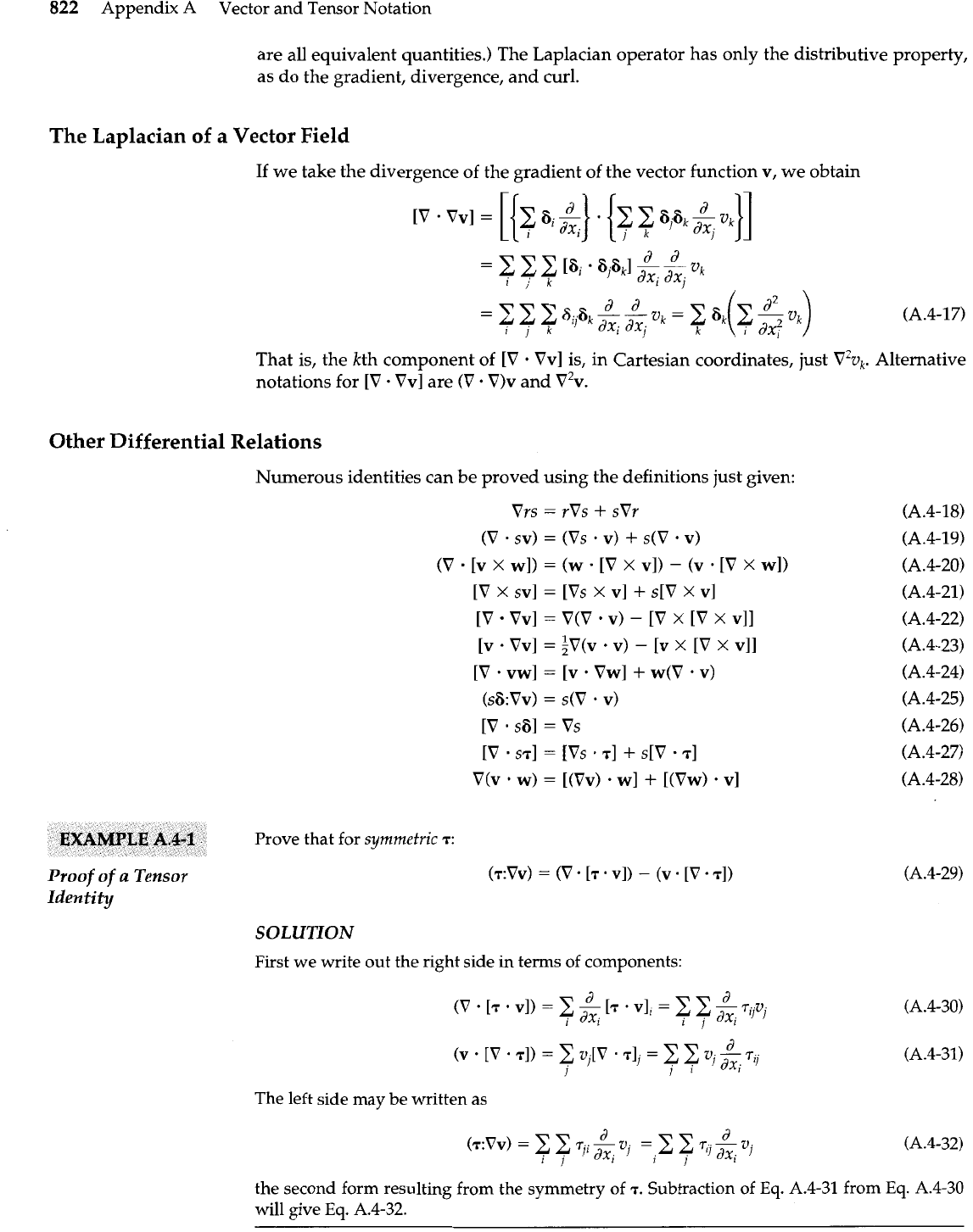
822
Appendix
A
Vector and Tensor Notation
are all equivalent quantities.) The Laplacian operator has only the distributive property,
as do the gradient, divergence, and curl.
The Laplacian of a Vector Field
If
we take the divergence of the gradient of the vector function
v,
we obtain
That is, the kth component of
[V
.
Vvl
is, in Cartesian coordinates, just
V2vk.
Alternative
notations for
[V
.
Vvl
are
(V
.
V)v
and
V2v.
Other Differential Relations
Numerous identities can be proved using the definitions just given:
Vrs
=
rVs
+
sVr
(V
-
SV)
=
(VS
'
V)
+
s(V
'
V)
(V
[v
X
w])
=
(w
.
[V
X
v])
-
(v
'
[V
X
w])
[V
x
sv]
=
[Vs
X
vl
+
s[V
X
vl
[V
Vv]
=
V(V
.
v)
-
[V
X
[V
X
v]]
[v
'
Vv]
=
iV(v
'
v)
-
[v
X
[V
X
v]]
[V
.
vw]
=
[v
'
Vw]
+
w(V
'
v)
(s6:Vv)
=
s(V
.
v)
[V
.
s61
=
Vs
[V 'ST]
=
[VS
'71
f
s[V
'71
V(v
.
W)
=
[(Vv)
'
w]
+
[(Vw)
'
vl
Prove that for
symmetric
T:
Proof
of
a
Tensor
Identity
SOLUTION
First we write out the right side in terms of components:
The left side may be written as
the second form resulting from the symmetry of
T.
Subtraction of
Eq.
A.4-31 from
Eq.
A.4-30
will give
Eq.
A.4-32.
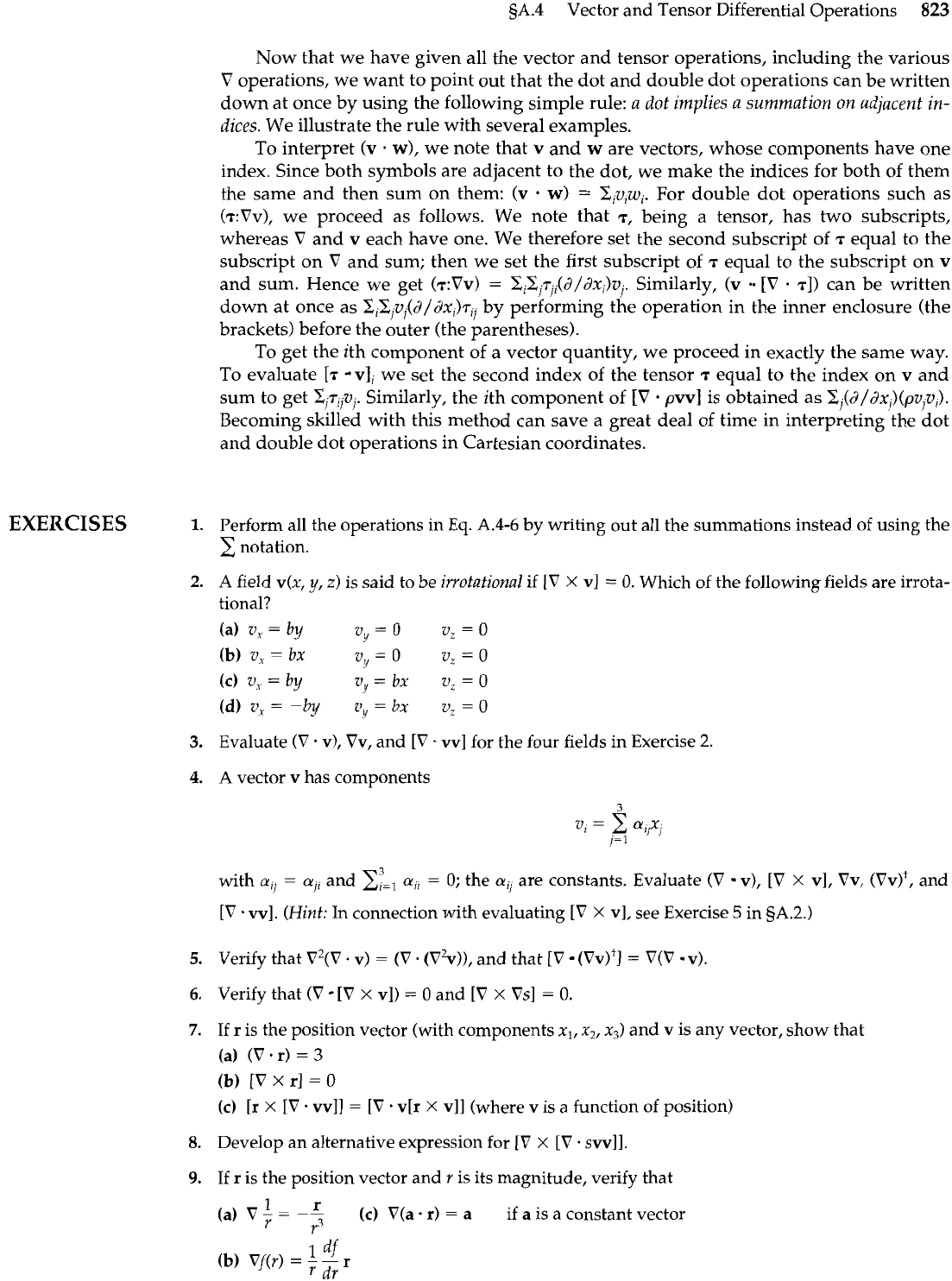
5A.4
Vector and Tensor Differential Operations
823
Now that we have given all the vector and tensor operations, including the various
V
operations, we want to point out that the dot and double dot operations can be written
down at once by using the following simple rule: a dot implies a summation on adjacent in-
dices. We illustrate the rule with several examples.
To interpret (v
w), we note that v and
w
are vectors, whose components have one
index. Since both symbols are adjacent to the dot, we make the indices for both of them
the same and then sum on them: (v
.
w)
=
Ziv,wi. For double dot operations such as
(T:VV), we proceed as follows. We note that T, being a tensor, has two subscripts,
whereas
V
and v each have one. We therefore set the second subscript of
T
equal to the
subscript on
V
and sum; then we set the first subscript of
T
equal to the subscript on v
and sum. Hence we get (T:VV)
=
SiZj.rji(d/dxi)vj. Similarly, (v [V
-
11)
can be written
down at once as ZiC,vi(d/dxi).r,, by performing the operation in the inner enclosure (the
brackets) before the outer (the parentheses).
To get the ith component of a vector quantity, we proceed in exactly the same way.
To evaluate [T
vIi we set the second index of the tensor
T
equal to the index on v and
sum to get Zjrijvj. Similarly, the ith component of [V
.
pvvl is obtained as Ci(d/dxi)(pv,vi).
Becoming skilled with this method can save a great deal of time in interpreting'the dot
and double dot operations in Cartesian coordinates.
EXERCISES
1.
Perform all the operations in
Eq.
A.4-6
by writing out all the summations instead of using the
notation.
2.
A
field v(x,
y,
z)
is
said to be ivvotational if
[V
X
v]
=
0.
Which of the following fields are irrota-
tional?
(a)
v,
=
by
v,=O
v,=O
(b)
v,
=
bx
v!,
=
0
vz
=
0
(c)
v,
=
by
v,
=
bx
vZ
=
0
(d)vx=-by
z~,,=bx
vZ=O
3.
Evaluate
(V
.
v), Vv, and [V
.
vv] for the four fields in Exercise
2.
4.
A
vector v has components
with
ail
=
aji
and
x:=,
ail
=
0;
the
ap
are constants. Evaluate
(V
v),
[V
x
vl, Vv, (Vv)', and
[V
.
vvl. (Hint:
In
connection with evaluating
[V
X
v], see Exercise
5
in
5A.2.)
5.
Verify that
V2(v
.
V)
=
(V
-
(V2v)), and that
[V
(Vv)+]
=
V(V
v).
6.
Verify that
(V
[V
x
v])
=
0
and
[V
x
Vs]
=
0.
7.
If r is the position vector (with components x,,
x,,
x3) and v is any vector, show that
(a)
(V
.
r)
=
3
(b)
[V
X
rl
=
0
(c)
[r
X
[V
.
vvll
=
[V
-
v[r
X
v]] (where v is
a
function of position)
8.
Develop an alternative expression for [V
X
[V
.
swll.
9.
If
r
is the position vector and
r
is its magnitude, verify that
1
r
(a)
V
-
=
--
r
y"
(c)
V(a. r)
=
a
if
a
is a constant vector
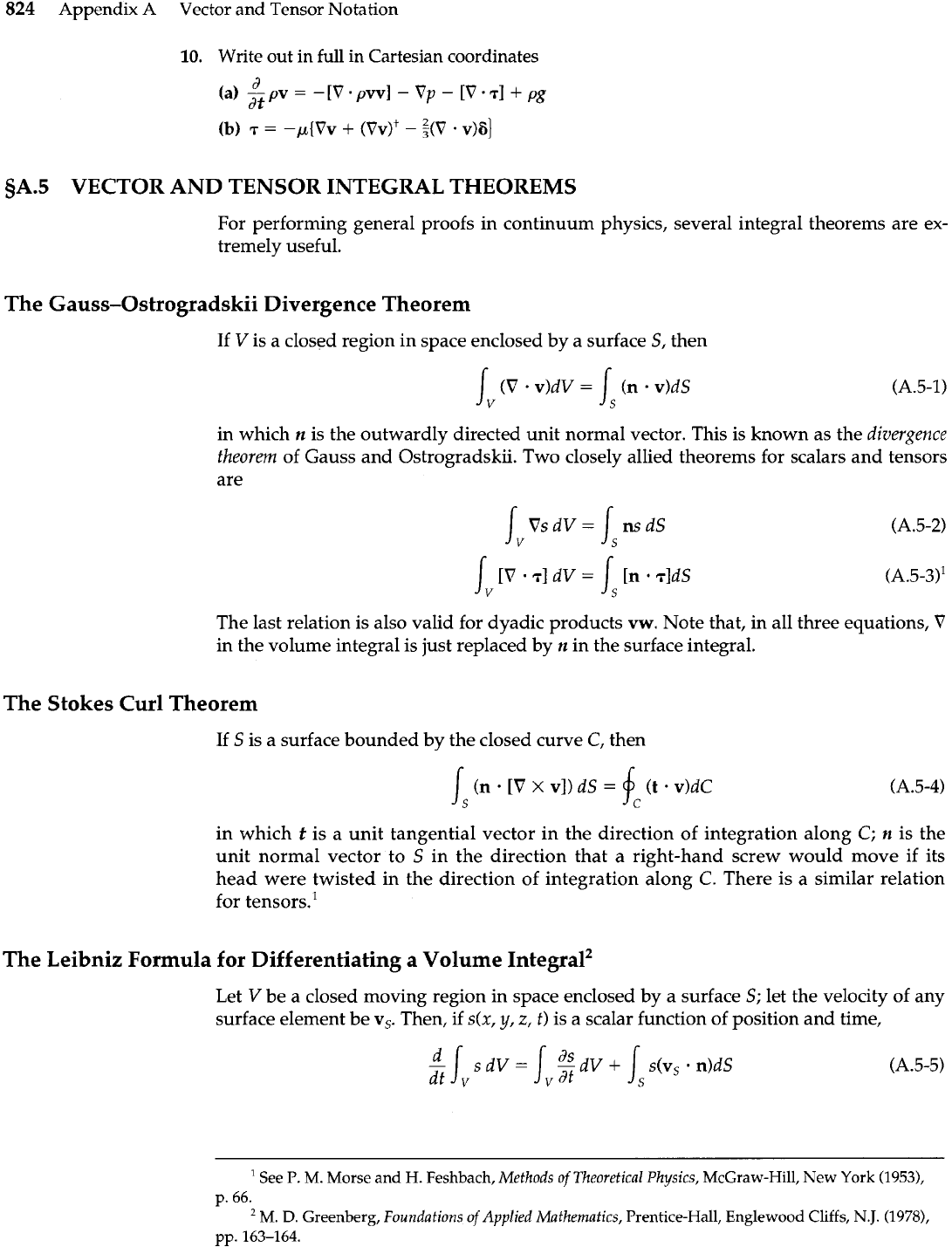
824
Appendix A Vector and Tensor Notation
10.
Write out in full in Cartesian coordinates
d
(a)
-pv
=
-[V-pwl
-
Vp
-
[V-TI
+
pg
dt
(b)
T
=
-p{Vv
+
(VV)~
-
$(V
.
v)6]
5A.5
VECTOR AND TENSOR INTEGRAL THEOREMS
For performing general proofs in continuum physics, several integral theorems are ex-
tremely useful.
The Gauss-Ostrogradskii Divergence Theorem
If
V
is a closed region in space enclosed by a surface
S,
then
in which
n
is the outwardly directed unit normal vector. This is known as the
divergence
theorem
of Gauss and Ostrogradskii. Two closely allied theorems for scalars and tensors
are
The last relation is also valid for dyadic products
vw.
Note that, in all three equations,
V
in the volume integral is just replaced by
n
in the surface integral.
The Stokes Curl Theorem
If
S
is a surface bounded by the closed curve C, then
in which
t
is a unit tangential vector in the direction of integration along
C;
n
is the
unit normal vector to
S
in the direction that a right-hand screw would move if its
head were twisted in the direction of integration along C. There is a similar relation
for tensors.'
The Leibniz Formula for Differentiating a Volume
integral2
Let
V
be a closed moving region in space enclosed by a surface
S;
let the velocity of any
surface element be
v,.
Then, if
s(x,
y,
z,
t)
is a scalar function of position and time,
'
See
P.
M. Morse and
H.
Feshbach,
Methods of Theoretical Physics,
McGraw-Hill, New York (1953),
p.
66.
M.
D.
Greenberg,
Foundations of Applied Mathematics,
Prentice-Hall, Englewood Cliffs,
N.J.
(1978),
pp.
163-164.

sA.6 Vector and Tensor Algebra in Curvilinear Coordinates
825
This is an extension of the Leibniz formula for differentiating a single integral (see Eq.
C.3-
2);
keep in mind that V
=
V(t) and
S
=
St).
Equation A.5-5 also applies to vectors and
tensors.
If the integral is over a volume, the surface of which is moving with the local fluid
velocity (so that v,
=
v), then use of the equation of continuity leads to the additional
useful result:
in which
p
is the fluid density. Equation A.5-6 is sometimes called the Reynolds transport
theorem.
EXERCISES
1.
Consider the vector field
Evaluate both sides of Eq. A.5-1 over the region bounded by the planes xl
=
0, x1
=
1;
x2
=
0,
x2
=
2; x3
=
0,
X3
=
4.
2.
Use the same vector field to evaluate both sides of Eq. A.5-4 for the face
x,
=
1
in Exercise 1.
3.
Consider the time-dependent scalar function:
Evaluate both sides of Eq. A.5-5 over the volume bounded by the planes:
x
=
0, x
=
t; y
=
0,
y
=
2t;
z
=
0,
z
=
4t. The quantities x, y, z,
t
are dimensionless.
4.
Use Eq. A.5-4 (with
v
replaced by
T)
to show that, when
7ki
=
zj
~ijk
xj,
where
r
is the position vector locating a point on
C
with respect to the origin.
5.
Evaluate both sides of Eq. A.5-2 for the function s(x, y,
z)
=
x2
+
y2
+
z2.
The volume
V
is the
triangular prism lying between the two triangles whose vertices are (2,0, O), (2,1,
O),
(2,0,3),
and(-2,0,0),(-2,1,0),(-2,0,3).
5A.6 VECTOR AND TENSOR ALGEBRA
IN CURVILINEAR COORDINATES
Thus far we have considered only Cartesian coordinates
x,
y,
and
z.
Although formal de-
rivations are usually made in Cartesian coordinates, for working problems it is often
more natural to use curvilinear coordinates. The two most commonly occurring mrvilin-
ear coordinate systems are the cylindrical and the spherical. In the following we discuss
only these two systems, but the method can also be applied to all orthogonal coordinate
systems-that is, those in which the three families of coordinate surfaces are mutually
perpendicular.
We are primarily interested in knowing how to write various differential operations,
such as Vs, [V
x
v],
and (T:VV) in curvilinear coordinates. It turns out that we can do this
in a straightforward way if we know, for the coordinate system being used, two things:
(a) the expression for
V
in curvilinear coordinates; and (b) the spatial derivatives of the
unit vectors in curvilinear coordinates. Hence, we want to focus our attention on these
two points.
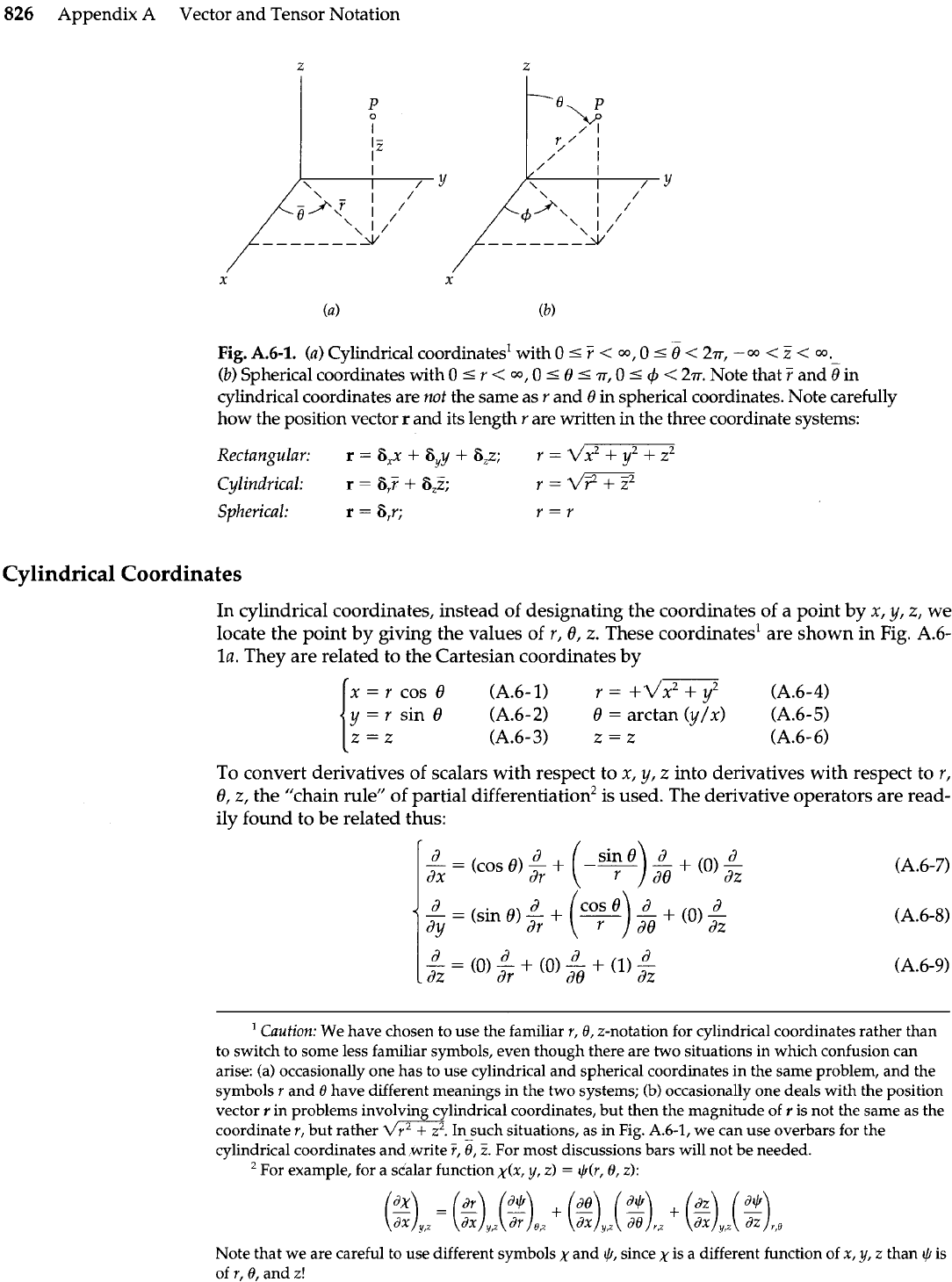
826
Appendix A Vector and Tensor Notation
-
Fig.
A.6-1.
(a)
Cylindrical coordinates' with
0
s
7
<
w,
0
s
0
<
2~r,
-a
<
Z
<
a.
(b)
Spherical coordinates with
0
5
r
<
m,
0
5
0
5
T,
0
5
4
<
27~.
Note that
T
and
$
in
cylindrical coordinates are
not
the same as
r
and
0
in spherical coordinates. Note carefully
how the position vector
r
and its length
r
are written
in
the three coordinate systems:
Rectangular:
r
=
6,x
+
6,y
+
6,z;
r
=
v\/Jc2
+
y2
+
z2
Cylindrical:
r
=
6,F
+
6,Z;
r
=
V'FT~
Spherical:
r
=
67; r
=
r
Cylindrical Coordinates
In cylindrical coordinates, instead of designating the coordinates of a point
by
x, y, z, we
locate the point by giving the values of r, 0,
z.
These coordinates1 are shown in Fig. A.6-
la.
They are related to the Cartesian coordinates
by
x
=
r cos 0 (A.6-1) r
=
+dx2
+
y2 (A.6-4)
y
=
r sin 0 (A.6-2) 0
=
arctan (y/x) (A.6-5)
z=z
(A.6-3)
z
=
z
(A.6-6)
To convert derivatives of scalars with respect to x,
y,
z
into derivatives with respect to r,
0, z, the "chain rule" of partial differentiation2 is used. The derivative operators are read-
ily found to
be
related thus:
d
sin
0
d
d
(COSO)-+
(0)dZ
dr
d
d
{
&
=
(sin 0)
+
('7)
+
io),
'
Caution:
We have chosen to use the familiar
r,
0,
z-notation for cylindrical coordinates rather than
to switch to some less familiar symbols, even though there are two situations in which confusion can
arise: (a) occasionally one has to use cylindrical and spherical coordinates in the same problem, and the
symbols
r
and
I3
have different meanings in the two systems;
Cb)
occasionally one deals with the position
vector
r
in problems involving cylindrical coordinates, but then the magnitude of
r
is not the same as the
coordinate
r,
but rather
m.
In such situations, as in Fig.
Ah-1,
we can use overbars for the
cylindrical coordinates and write
T,
8,~.
For most discussions bars will not be needed.
For example, for a scalar function
~(x,
y,
z)
=
+(r,
0,
z):
Note that we are careful to use different symbols
,y
and
I,//,
since
x
is a different function of
x,
y,
z than
I,!I
is
of
r,
13,
and
z!
